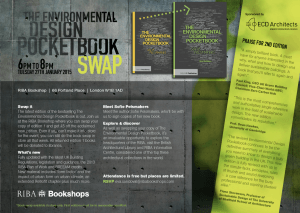
This year the 11th International Architectural Humanities Research Association conference was hosted at Newcastle University and focused on ‘Industries of Architecture’, aiming to bring together architectural theorists, historians and designers to discuss the industrial, technical and socio-economic contexts in which the production of building takes place in the present day.
I was invited to chair a 3 hour ‘Retrofit in practice: what next?’ workshop on November 14th and I invited Dr David Kroll to co-chair our inter-disciplinary workshop. We opened our workshop up to submission of abstracts and ‘position statements’ and based on these submissions we invited a diverse group of 12 architectural practitioners, researchers, conservationists, lecturers and theorists to lead the workshop content and debate. You can read more about our contributors here (and in due course presentations will be uploaded). We also managed to obtain generous sponsorship from Saint-Gobain and from ECD architects.
Our workshop was set against the background of the UK’s ~ 26.7 million existing dwellings (DECC, 2012) and ~ 1.8 million non-domestic buildings (UKGBC, 2011). The energy use of housing alone, which is mostly used to keep people warm in their homes (Palmer, 2011), contributes to about 1/3rd of the UK’s carbon emissions (DECC, 2011). Hence there is a real urgency to reduce this energy use in buildings; while this will also increase thermal comfort of occupants and helps people out of fuel poverty.
This brings with it a whole host of challenges, but also opportunities and this is what we really tried to capture in our workshop. Our workshop presenters touched on key issues that are related to the retrofit challenge, such as: the need for aesthetic upgrades as part of building maintenance when buildings meet or exceed their intended lifespan; lack of on-site skills to undertake robust building upgrades; the need for project management, assessment methods, new models and tools and different procurement routes. There was also a focus on performance testing, community benefits of upgrades and dangers of ill-conceived or executed retrofits, leading to unintended technical and aesthetic consequences.
It also became clear from discussion that terms such as ‘retrofitting’, ‘conservation’ and ‘heritage’ have overlaps but are not clearly defined at the moment.
For example what do we mean by conservation and heritage? What is the value in listed buildings we are trying to protect, is it the entire building or a specific aspect? And, if it is only part of a building that is ‘valued’, perhaps listed building consent – considered a barrier to upgrading buildings – may not be necessary at all?

Co-chair Dr David Kroll
What do we mean by retrofitting? Does retrofit mean just adding, or changing, or can it also mean taking away? Or any of these together? Does retrofitting include renewable technologies as add-ons such as solar panels on a roof? Or is retrofitting’s key concern the fabric upgrade?
Should we not touch a heritage building at all? Or is wrapping the building in a new protective, ‘conserving layer’ part of conservation, as it increases the durability of the building and retains, protects, ‘conserves’ its structure and purpose?
On the other hand, some argued, given the sheer scale and urgency of the task ahead for many buildings which are not listed, we might just need to “get the job done”. If millions of housing are not of any significant quality or aesthetic, can we use the need for sustainable retrofit as an opportunity to enhance the architectural quality of our buildings, while increasing occupant thermal comfort and reducing carbon emissions associated with space-heating energy?
It became clear that there is a huge opportunity, but that we also have a long way to go in the architecture community, evidenced by a quote from the Farrell review: “refurbishment and retrofitting had not been considered to be architectural issues, and these concerns still struggle to be accepted as legitimate by the architectural community” (Farrell, 2014).
The workshop’s full summing up text can be found here.
DECC 2011. DUKES – Domestic Energy Consumption in the UK 2011. In: DECC (ed.) Publication URN 11D/808 ed. London.
DECC 2012. Statistical release: Experimental Statistics; Estimates of home insulation levels in Great Britain: January 2012. In: CHANGE, D. O. E. C. (ed.). London: Department of Energy & Climate Change.
FARRELL, T. 2014. The Farrell Review of Architecture + the Built Environment In: DEPARTMENT FOR CULTURE, M. A. S. (ed.). London.
PALMER, J., COOPER, I. 2011. Great Britain’s Housing Energy fact file – 2011. DECC.
UKGBC 2011. Uk-GBC Task Group Report on Carbon Emissions in Existing Non-Domestic Buildings. In: UKGBC (ed.).
 Close
Close




